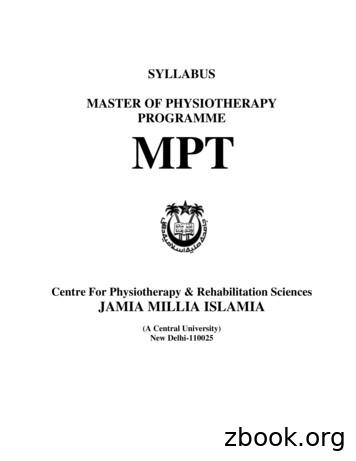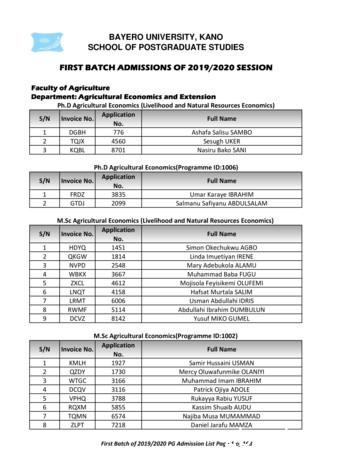Physiotherapy Management Of Temporomandibular Joint
Patient information leafletRoyal Surrey County HospitalNHS Foundation TrustPhysiotherapy management ofTemporomandibular Joint (TMJ) painPhysiotherapy Department
What is the TMJ?The jaw is also known as the TMJ or Temporomandibular Joint. It canbe painful as the result of injury, inflammatory disease, poor posturesand habits or growth disorders. This leaflet gives you advice onmanaging your jaw pain.Illustration provided bywww.intelligentdental.comThe TMJ is made up of several parts: the lower jaw (or mandible) and thesocket (or temporal bone). In between the mandible and the socket is adisc. The disc allows the joint to glide smoothly on opening and closing.The joint is also held in place by muscles and ligaments.What are the signs and symptoms of TMJ dysfunction?Pain is the most common symptom of TMJ problems, although noteveryone gets pain. Symptoms can include: Pain in the jaw joints and facial muscles Clicking, grinding or locking of the jaw Headaches & Dizziness Difficulty opening or closing the mouth comfortably Pain on talking, chewing (especially hard food) & yawning Ear pain, ringing in the ears (tinnitus) & hearing loss2
What causes TMJ pain?There are a number of causes and frequently it is a combination ofthese rather than one single cause: Trauma, for example a blow to the jaw either directly to the jointor elsewhere on the jaw. Overactivity of the jaw muscles. This can occur from continuousclenching or grinding the teeth. Wear and tear of the cartilage inside in the joint Arthritis Increased sensitivity to pain linked to stressWhat are the aims of Physiotherapy treatment? Relief pain Minimise stiffness Restore normal function and mobilityAdvice Apply heat or ice for 15-20 minutes on the area of pain Painkillers Massage the joint and surrounding musclesDO: Exercise your jaw regularly on your physiotherapist’s advice. Be aware when you are clenching or grinding your teeth. Change to a soft food diet and avoid hard and chewy foods. Cut tough food into small pieces. 3
AVOID: Excessive chewing (e.g. Nails, gum, pen tops & your cheek).This stops the jaw from having a rest. Excessive mouth opening (e.g. Yawning). Resting your jaw in your hand or holding your telephone to yourear using just your shoulders. Sleeping face down, as this puts a strain on the neck.Posture CorrectionBad posture in sitting or lying causes prolonged over-stretching of theligaments and surrounding tissues including those of the jaw.By learning to keep a good posture, it is possible to prevent or relieveyour neck and jaw pain.Exercises1. Relaxed Jaw PositionPlace the tongue lightly on the top of your mouth behind your upper frontteeth, allowing the teeth to come apart and relaxing the jaw muscles.2. ‘Goldfish’ Exercise 1 (partial opening)1. Keep tongue on the roof of your mouth.2. Place one index finger on the TMJ.3. Place your other index finder on your chin.4. Allow the lower jaw to partially drop downand back with help from the index finger.5. Monitor this partial jaw opening in a mirrorto make sure the opening is straight(tongue stays up).Repeat 6 times, 6 times a day4
3. ‘Goldfish’ Exercise 2(partial opening)1. Keep tongue on the roof of your mouth.2. Place one finger on each TMJ.3. Allow the lower jaw to partially drop downand back to bring the chin to the throat.4. M onitor this partial jaw opening in amirror to make sure the opening isstraight.Repeat 6 times, 6 times a day4. ‘Goldfish’ Exercise 3 (full opening)1. Keep tongue on the roof of your mouth.2. Place one index finger on the TMJ.3. Place your other index finder onyour chin.4. Allow the lower jaw to fully drop downand back with help from the index finger.5. Monitor this full jaw opening in a mirrorto make sure the opening is straight(tongue stays up).(Progression: perform with tonguedropped off the roof of the mouth) 5
5. ‘Goldfish’ Exercise 4 (full opening)1. Keep tongue on the roof of your mouth.2. Place one finger on each TMJ.3. Allow the lower jaw to fully drop downand back to bring the chin to the throat.4. M onitor this full jaw opening in a mirrorto make sure the opening is straight.Repeat 6 times, 6 times a day(Progression: perform with tonguedropped off the roof of the mouth)6
6. Mandibular Stabilisation ExercisesMaintaining the jaw in a neutral position, apply gentle pressure to thejaw using your index finger/thumb on:Opening:To the left:To the right:Hold for 2 seconds, repeat 5 times, 5 times a day 7
7. Mandibular Stabilisation Exercises(Advanced)1. Place knuckle of index finger betweentop and bottom teeth.2. Remove it, keeping the teeth separatedone-knuckle apart.3. Apply gentle pressure to the to thejaw using your index finger/thumb asdemonstrated in the pictures above.8
8. Cervical Retraction ‘Chin Tucks’Standing or sitting with shoulders backand chest up, bring your chin straight back,creating a ‘double chin’. Do not allow yourhead to bend up or down as you do this.Hold for 2-3 seconds, repeat 10 times9. Neck Stretches (If these are required, your physiotherapistwill provide you with an additional exercise sheet) 9
tact DetailsPhysiotherapy DepartmentRoyal Surrey County HospitalEgerton RoadGuildfordGU2 7XXTel: 01483 464 153Author: Liora Jackson & Neha KholiaPhysiotherapy Department10
Notes 11
Royal Surrey County Hospital (RSCH) NHSFoundation Trust fully subscribes to the NationalPatient Safety Agency (NPSA) Being Open bestpractice framework, November 2010.Contact details of independent advocacy services canbe provided by our Patient Advice and Liaison Service(PALS) who are located in far left corner as you enterthe main reception area. PALS are also your firstpoint of contact for health related issues, questionsor concerns surrounding RSCH patient services.Contact detailsTelephone: 01483 402757Email: rsc-tr.pals@nhs.netOpening hours: 09.30–16.30 Monday to FridayIf you would like information documents in largeprint, on tape or in another language or formplease contact us on: 01483 402757Review date: January 2014Author: Neha KholiaPIN120501–487 The Royal Surrey County HospitalNHS Foundation Trust 2012
What are the aims of Physiotherapy treatment? Relief pain Minimise stiffness Restore normal function and mobility Advice Apply heat or ice for 15-20 minutes on the area of pain Painkillers Massage the joint and surrounding muscles DO: Exer
physiotherapy. To offer affordable physiotherapy education at postgraduate level. To develop competency and skill sets in advanced physiotherapy assessment and techniques in physiotherapists. To have highly competent physiotherapy professionals in Cardiopulmonary, Orthopaed
3.8 Statistical Data of Physiotherapy & Disability Rehabilitation Care Service 3.8.1 General Physiotherapy In this department patients with joint pain and muscle pain are provided with Physiotherapy based treatment. Table 3.8.1.1 General Physiotherapy Clinic at Lallubhai compound center. Sr. No. Conditions Treated Patient No. 1 Spine 57
The following services are unproven and not medically necessary for treating disorders of the temporomandibular joint (TMJ) due to insufficient evidence of efficacy: Biofeedback Craniosacral manipulation Passive rehabilitation therapy Low-load prolonged-duration stretch (LLPS) devices ies Botulinum Toxins A and B
DBEB/DBEC 2203 Introduction to Temporomandibular Joint Disorders for the General Dentist (0.5 cr) rd 2nd, 3 , 4th Limits: 20 max Instructor: AbdelFattah Day/Time: Tue, noon Description: This course is intended to introduce students to the basics of the group of disorders known as Temporomandibular Joint Disorders (TMD). After reviewing the
Department: Physiotherapy 1 YLHF 4724 Fatima Yahaya ALIYU 1 GWNB 5527 Abdulmunaf Umar FARUK 1 YNTB 6633 Yakubu ABUBAKAR 1 FDMW 1722 Edward Yohanna BAHAGO M.Phil/Ph.D Physiotherapy(Programme ID:2026) S/N Invoice No. Application No. Full Name Ph.D Physiotherapy (Cardiopulmonary Physiotherapy)(
Apr 23, 2018 · The Physiotherapy Competency Examination (PCE) tests whether qualified exam candidates have demonstrated a minimum standard of practice. It fairly and accurately evaluates the competencies needed to practise physiotherapy. All physiotherapy regula
Manual Therapy (MPT) Bachelor of Physiotherapy (BPT) Physiotherapy Physiotherapy Physiotherapy University of Otago, New Zealand Manipal University, India The TN Dr MGR Medical University, India . Work experience Part-time (teaching/research) positions held while doi
Introduction 1 Part I Ancient Greek Criticism 7 Classical Literary Criticism: Intellectual and Political Backgrounds 9 1 Plato (428–ca. 347 bc)19 2 Aristotle (384–322 bc)41 Part II The Traditions of Rhetoric 63 3 Greek Rhetoric 65 Protagoras, Gorgias, Antiphon, Lysias, Isocrates, Plato, Aristotle 4 The Hellenistic Period and Roman Rhetoric 80 Rhetorica, Cicero, Quintilian Part III Greek .























